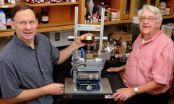(Press-News.org) COLUMBUS, Ohio – There is yet no straightforward way to determine the optimal dose level and treatment schedules for high-dose radiation therapies such as stereotactic radiation therapy, used to treat brain and lung cancer, or for high-dose brachytherapy for prostate and other cancers.
Radiation oncologists at the Ohio State University Comprehensive Cancer Center-Arthur G. James Cancer Hospital and Richard J. Solove Research Institute (OSUCCC-James) may have solved the problem by developing a new mathematical model that encompasses all dose levels.
Typically, radiation therapy for cancer is given in daily, low doses spread over many weeks. Oncologists often calculate the schedules for these fractionated, low-dose treatment courses using a mathematical model called the linear-quadratic (LQ) Model. The same calculation model is used to evaluate radiation response, interpret clinical data and guide clinical trials.
"Unfortunately the LQ Model doesn't work well for high-dose radiation therapy," says co-author Dr. Nina Mayr, professor of radiation oncology at the OSUCCC-James. "Our study resolves this problem by modifying the current method to develop the Generalized LQ (gLQ) Model that covers all dose levels and schedules."
If verified clinically, the Generalized gLQ Model could guide the planning of dose and schedules needed for the newer radiosurgery and stereotactic radiation therapy and high-dose brachytherapy procedures that are increasingly used for cancer patients, she says.
"Developing proper radiation dose schedules for these promising high-dose treatments is very challenging," Mayr says. "Typically, it involves phase I dose-finding studies and a long, cumbersome process that allows only gradual progression from the pre-clinical and clinical trial stages to broader clinical practice."
The new gLQ Model could allow oncologists to design radiation dose schedules more efficiently, help researchers conduct clinical trials for specific cancers more quickly and make these high-dose therapies available to cancer patients much sooner, Mayr says.
Fractionated low-dose therapy causes cumulative damage to tumor cells during the many weeks of exposure, while causing minimal damage to hardier normal cells. Patients, however, must return repeatedly to the hospital for many weeks to complete their treatment.
High-dose therapy has become possible because of advances in computer and radiation technology. It uses multiple beams of radiation that conform tightly to a tumor's shape. They converge on the cancer to deliver higher total radiation levels, while sparing normal tissues. This kills more tumor cells per treatment, so far fewer treatments are needed overall.
The new study, published recently in the journal Science Translational Medicine, tested the gLQ Model in cell and animal models, and is expected to be evaluated soon in clinical trials.
"Our Generalized LQ Model determines appropriate radiation levels across the entire wide spectrum of doses, from low and high, and from many to very few treatments, which is a new approach," Mayr says.
###
Note: First author Dr. Jian Z. Wang, director of the OSUCCC-James Tumor Response Modeling Laboratory in Radiation Oncology, passed away unexpectedly in June 2010. He was largely responsible for developing the Generalized gLQ Model.
END
BETHESDA, Md., Sept. 2, 2010 – The American Society for Biochemistry and Molecular Biology expressed its disapproval and disappointment this week in response to the Aug. 23 ruling in the U.S. District Court for the District of Columbia that granted a preliminary injunction barring federal funding of embryonic stem-cell research.
In a statement, the society said the decision, which came in response to a lawsuit filed by two adult stem-cell researchers, effectively halts human embryonic stem-cell research in the United States and "represents a crossroads in American scientific ...
COLLEGE PARK, Md. – A new report by terrorism researchers at the University of Maryland concludes that the deadly hostage-taking incident at the Discovery Communications headquarters in suburban Washington, D.C. meets the criteria of a terrorist act – a rare one for media organizations and the nation's capital region. Hostage-taking, though, is a familiar pattern in capital-region terror, the researchers add.
The report from the University of Maryland's START Center – the federally funded National Consortium for the Study of Terrorism and Responses to Terrorism – also ...
Tropical Depression Nine strengthened yesterday into Tropical Storm Gaston, but today it ran into dry and stable air and weakened back into a depression again.
When NASA's Aqua satellite flew over Gaston early this morning, Sept. 2 at 0423 UTC (12:23 a.m. EDT), the infrared image taken from the Atmospheric Infrared Sounder (AIRS) instrument showed that Tropical Depression Gaston seemed to have a compact circulation with some high, cold thunderstorm cloud tops around its center of circulation. Those clouds reached so high into the troposphere that they were colder than ...
AMES, Iowa – Iowa State University researchers have found a way to produce high-value chemicals such as ethylene glycol and propylene glycol from biomass rather than petroleum sources.
Walter Trahanovsky, an Iowa State professor of chemistry who likes to write out the chemical structures of compounds when he talks about his science, was looking to produce sugar derivatives from cellulose and other forms of biomass using high-temperature chemistry. And so he and members of his research group studied the reactions of cellulosic materials in alcohols at high temperatures ...
ANN ARBOR, Mich. — School children who consume foods purchased in vending machines are more likely to develop poor diet quality – and that may be associated with being overweight, obese or at risk for chronic health problems such as diabetes and coronary artery disease, according to research from the University of Michigan Medical School.
The study also looked at foods sold in school stores, snack bars and other related sales that compete with USDA lunch program offerings and found that these pose the same health and diet risks in school-aged children.
"The foods that ...
NASA's Terra satellite captured the changing Tropical Storm Kompasu over Korea and China very early today, as it makes its way east to northern Japan. It is becoming extratropical.
The Moderate Resolution Imaging Spectroradiometer (MODIS) instrument aboard NASA's Terra satellite captured a visible image of Tropical Storm Kompasu at 02:15 UTC on Sept. 2 (10:15 p.m. EDT Sept. 1) as it was moving over Korea and China. The storm appeared disorganized as there was no visible center of circulation. The Joint Typhoon Warning Center, the organization that forecasts tropical ...
Singapore, September 3, 2010 — Novartis announced today that scientists at the Novartis Institute for Tropical Diseases (NITD), in collaboration with researchers from the Genomics Institute of the Novartis Research Foundation (GNF), the Swiss Tropical and Public Health Institute and The Scripps Research Institute have discovered a novel compound that shows promise as a next generation treatment for drug resistant malaria. Major support for the project was provided by the Wellcome Trust, the Medicines for Malaria Venture (MMV), A*STAR, Singapore and the U.S. government.
Published ...
Female induced pluripotent stem (iPS) cells, reprogrammed from human skin cells into cells that have the embryonic-like potential to become any cell in the body, retain an inactive X chromosome, stem cell researchers at UCLA have found.
The finding could have implications for studying X chromosome-linked diseases such as Rett syndrome, caused by mutations in a gene located on the X chromosome.
The findings differ from those seen in mouse skin cells that are reprogrammed into iPS cells, in which the inactive X chromosome reactivates, said Kathrin Plath, senior author ...
Uninsured minority pedestrians hit by cars are at a significantly higher risk of death than their insured white counterparts, even if the injuries sustained are similar, new research from Johns Hopkins suggests.
The death rate disparity is compounded by the fact that minority pedestrians are far more likely than white pedestrians to be struck by motor vehicles, according to a study published in the August issue of the journal Surgery.
"It's a double whammy," says Adil H. Haider, M.D., M.P.H., an assistant professor of surgery at the Johns Hopkins University School ...
Researchers at Yale School of Medicine have developed a new animal model for studying hemophilia A, with the goal of eventually treating people with the disorder. Hemophilia A, a hereditary defect that prevents blood from clotting normally, is caused by a variety of mutations in the factor VIII gene.
Published online in the Journal of Thrombosis and Haemostasis, the study aimed to provide a better understanding of hemophilia A, according to first author and veterinarian Carmen Jane Booth, assistant professor of comparative medicine, and co-director of Mouse Research Pathology ...


